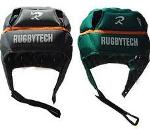 A medical study claims protective skull caps like those worn by Rugby World Cup winner Victor Vito do nothing to protect against concussion.
A medical study claims protective skull caps like those worn by Rugby World Cup winner Victor Vito do nothing to protect against concussion.
And as concern grows over the prevalence of head injuries, it can be revealed that the International Rugby Board has funded an on field trial involving experimental protective helmets. The helmets were put through their paces in a study involving 4000 players.
Over a period of about 30,000 playing hours, the group was split into three – one wearing the trial helmets, one wearing regulation skull caps, and another wearing whatever they normally played with, including no head gear.
In an article on an Australian academic website called The Conversation, Caroline Finch – a professor in injury research at Melbourne’s Monash University – has written of the trial study, which was funded by the IRB.
“We did that in a randomised control trial – the gold standard for studying these sorts of preventative measures – and we found there was actually no reduction in head injury or concussion rates with protective helmets, at all,” Finch wrote.
“We didn’t even find it with the players in the modified helmets, which had thicker padding. So we’ve got no evidence really that soft-shell helmets help prevent concussion, although they may prevent against superficial injuries. But we certainly wouldn’t be saying at this stage that this is a protective device that is going to prevent everything.”
Finch wrote that an earlier lab-based study by Andrew McIntosh – an associate professor of biomechanics at New South Wales University’s school of safety science – had shown that current headgear “might prevent superficial grazes but it won’t prevent concussions”.
“I have to say, too often people say the answer is to just put a helmet on, that’s going to solve everything,” she wrote.
Current IRB rules state most players who suffer concussion must complete a three-week playing and training stand-down.
The exception is for elite players, who are allowed to return to action earlier if they are deemed symptom-free by a neurological specialist.
Finch expressed concern about how the issue of concussion was being policed, referring to a recently published study by the British Journal of Sports Medicine which surveyed 2000 UK club players aged between 15-48.
About 10 per cent reported that they had suffered more than one concussion, but the majority weren’t told that they were required to complete a stand-down.
“Even more worryingly, the small proportion of players who did get advice ignored it,” Finch said.
Although head injuries gained a lot of media attention, they were not common.
Research suggested just 11 per cent of rugby injuries were related to concussion.
“Rugby, like most of our other football codes, is a contact sport and even a collision sport,” she wrote.
“Many of the injuries that occur in such sports are related to body contact, for example while tackling for the ball, even in scrum engagement, but also in players competing for a ball that’s moving around a field at a very fast pace.
“That’s another aspect of this game, like other football codes too, rugby is a running game, and so the most common injuries are to the lower limbs – knee, thigh, ankle – because it’s about running and changing direction.
Sorry cant post a picture, will try later again.